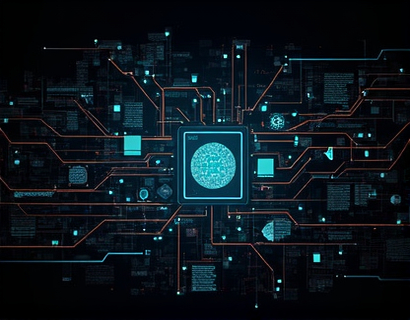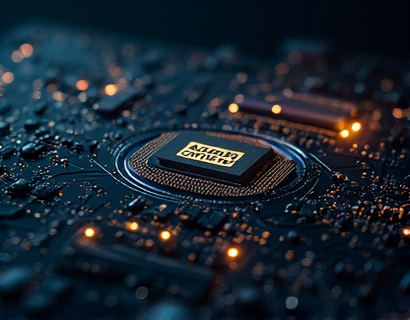Exploring the Synergy Between Crypto and AI: A Catalyst for Digital Transformation
The intersection of cryptocurrency and artificial intelligence (AI) represents a groundbreaking frontier in the realm of digital innovation. This synergy is not merely a convergence of two advanced technologies but a powerful catalyst for digital transformation, redefining how we approach applications, user experiences, and the future of technology. As tech-savvy individuals, AI enthusiasts, digital marketers, and early adopters increasingly recognize the potential of merging these two domains, the landscape of digital solutions is evolving at an unprecedented pace.
The integration of cryptocurrency and AI is fostering the creation of advanced applications that enhance user experiences and connect innovators with cutting-edge technology. This article delves into the transformative power of this synergy, exploring how it is revolutionizing digital strategies and offering new possibilities for businesses and individuals alike. By understanding the fundamental principles and practical applications of this fusion, we can better appreciate its impact on the future of technology.
Understanding Cryptocurrency and AI
To grasp the synergy between cryptocurrency and AI, it is essential to first understand each technology individually. Cryptocurrency, often referred to as digital or virtual currency, operates on a decentralized network known as a blockchain. This technology ensures transparency, security, and immutability, making it an ideal foundation for various financial and non-financial applications.
Artificial intelligence, on the other hand, encompasses a range of technologies designed to simulate human intelligence processes such as learning, reasoning, and self-correction. AI algorithms can analyze vast amounts of data, identify patterns, and make predictions or decisions with minimal human intervention. The combination of these two technologies creates a powerful toolset for innovation.
The Synergy of Crypto and AI
The synergy between cryptocurrency and AI emerges from their complementary strengths. Cryptocurrency provides a secure, decentralized, and transparent platform, while AI brings intelligent, data-driven capabilities. When combined, they can create applications that are not only secure and efficient but also intelligent and adaptive.
One of the primary ways this synergy manifests is through the use of smart contracts. Smart contracts are self-executing contracts with the terms of the agreement directly written into code. When integrated with AI, smart contracts can automate complex processes, execute transactions based on predefined conditions, and even adapt to changing circumstances. This fusion enhances the reliability and efficiency of decentralized applications (dApps), making them more robust and user-friendly.
Another significant area of synergy is in data management and analysis. AI algorithms can process and analyze large datasets to uncover insights that can inform decision-making. In the context of cryptocurrency, this means better risk management, fraud detection, and personalized financial services. For instance, AI-driven analytics can monitor blockchain transactions in real-time, identifying suspicious activities and enhancing security measures.
Enhancing User Experiences
The combination of cryptocurrency and AI is revolutionizing user experiences across various domains. In the realm of digital finance, AI-powered chatbots and virtual assistants can provide personalized investment advice, manage portfolios, and execute trades with minimal human intervention. These AI-driven tools, backed by the security and transparency of blockchain, offer users a seamless and secure financial experience.
In the world of gaming, the synergy between crypto and AI is giving rise to decentralized gaming platforms where players can own and trade in-game assets as non-fungible tokens (NFTs). AI algorithms can enhance gameplay by creating dynamic and adaptive environments, ensuring a more engaging and immersive experience. The use of cryptocurrency in these platforms ensures fair transactions and rewards, fostering a more inclusive and transparent gaming community.
For digital marketers, the integration of AI and cryptocurrency offers new opportunities for targeted advertising and customer engagement. AI can analyze user behavior and preferences to create highly personalized marketing campaigns, while cryptocurrency can facilitate secure and transparent transactions. This combination not only improves the effectiveness of marketing efforts but also builds trust with consumers by ensuring data privacy and security.
Innovating Business Models
The synergy between cryptocurrency and AI is also driving innovation in business models. Traditional industries are leveraging this fusion to create new revenue streams and enhance operational efficiency. For example, supply chain management can benefit from AI-driven predictive analytics combined with blockchain for transparent and tamper-proof tracking. This ensures better inventory management, reduces costs, and improves customer satisfaction.
In the healthcare sector, AI-powered diagnostic tools can analyze medical data stored on a blockchain, providing accurate and secure health records. This not only enhances patient care but also ensures compliance with data protection regulations. Similarly, in the real estate market, AI can optimize property listings and match them with potential buyers based on preferences and financial capabilities, all facilitated by cryptocurrency transactions.
Challenges and Considerations
While the potential of combining cryptocurrency and AI is vast, there are several challenges and considerations to keep in mind. One of the primary concerns is regulatory compliance. The decentralized nature of cryptocurrency and the rapidly evolving regulatory landscape pose significant challenges for businesses and developers. Ensuring compliance while innovating is crucial to avoid legal issues and maintain trust.
Another challenge is the technical complexity involved in integrating these technologies. Developing applications that seamlessly combine AI and blockchain requires expertise in both domains. This can be a barrier for smaller businesses and developers, necessitating collaboration and knowledge sharing within the community.
Security remains a paramount concern. While blockchain is inherently secure, the integration with AI introduces new vulnerabilities. AI models can be susceptible to adversarial attacks, where malicious actors manipulate input data to produce incorrect outputs. Robust security measures and continuous monitoring are essential to mitigate these risks.
Future Prospects
Looking ahead, the synergy between cryptocurrency and AI is poised to drive further innovation and transformation. As technology advances, we can expect more sophisticated applications that leverage the strengths of both domains. For instance, the development of AI-driven decentralized autonomous organizations (DAOs) could redefine governance and decision-making processes in various industries.
The rise of Web3, a vision for the next generation of the internet, is heavily influenced by the combination of cryptocurrency and AI. Web3 aims to create a decentralized, user-centric web where data ownership and privacy are prioritized. AI can play a crucial role in enhancing the user experience on Web3 platforms, making them more intuitive and personalized.
Moreover, the integration of AI and cryptocurrency is likely to spur the growth of new industries and business models. As more companies recognize the potential of this synergy, we can anticipate a surge in investments and innovations, leading to a more dynamic and interconnected digital ecosystem.
Conclusion
The convergence of cryptocurrency and AI represents a transformative force in the digital landscape. By combining the security, transparency, and decentralization of cryptocurrency with the intelligence and adaptability of AI, we can create advanced applications that enhance user experiences and drive innovation. As tech enthusiasts and professionals continue to explore this synergy, the future of digital solutions looks brighter and more promising than ever. Embracing this fusion is not just an option but a necessity for those looking to stay ahead in the rapidly evolving world of technology.










































